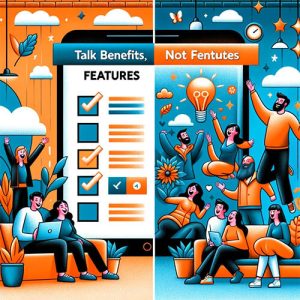Let’s be honest – writing isn’t always the most exciting part of running a website. As a business owner, you’d probably rather be designing a new product or talking to customers.
But here’s the thing: the text on your site shapes how people perceive your brand. It’s one of the main ways you communicate your story. So you want it to capture attention and convey the right message.
The good news is you don’t have to be Shakespeare to write compelling website copy. You just need to keep the reader in mind and focus on practical communication.
These tips can help you create website text that engages visitors and inspires action:
Talk Benefits, Not Features
Don’t simply list your product features or services offered. Readers glance right past dry descriptions. Instead, focus on the underlying benefits and transformations. How does your offering actually improve lives?
For example, a bank could say: “We offer personal checking accounts with no monthly fees.” Or they could say: “Feel confident knowing your money goes further with no hidden checking account fees each month.”
Paint a Picture
Help readers visualize how your product or service fits into their life. Use vivid descriptions to add color to mundane topics. Create a scene they can mentally step into.
A plumber could say: “We unclog drains.” Or they could say: “Picture arriving home after a long week only to find the kitchen sink overflowing with dirty water. Stop that nightmare before it happens by getting our drain cleaning services.”
Appeal to Emotions
Logical facts and stats have their place, but emotions are what truly drive decisions. Tap into feelings like joy, freedom, security, or hope. This gives readers something to identify with.
For example, an airline could say: “Our on-time arrival rate is 90%.” Or they could say: “Travel with us and experience the sheer joy of arriving right on time to see your loved ones.”
Write Like You Speak
Imagine explaining your business to a friend. Jot down your website text as if you were having a real conversation. Use natural language without too much formal or technical jargon. It makes the message feel more down-to-earth.
Trim the Fat
Edit mercilessly. Tighten up sentences by cutting unnecessary words. Break large paragraphs into smaller chunks that are easy to scan. Remove sections that don’t directly support your message.
Make It Relatable
Use examples, stories, and case studies to help readers see themselves using your product or service. Real-world scenarios are more tangible than hypothetical situations.
For instance, an accounting firm could explain: “If you own a small café, we’ll help you manage payroll, bills, and taxes.” This allows the reader to envision their business benefiting.
Mind the Structure
Well-organized text makes your message clear and accessible. Use bullet points, numbered lists, subheads, and bold text to highlight important information. Break up dense blocks of text by integrating relevant graphics or videos when possible.
Proofread for Polish
Typos and grammatical errors will undermine your brand’s professionalism – so be sure to proofread closely. Read your text out loud to catch awkward phrasing. Refine it until each sentence flows.
Website copy often requires more casual language than what you’d use in brochures or other marketing materials. Focus on simplicity, clarity, and showcasing your customers’ point of view.
With strategic words that speak to their needs, you can craft website content that resonates. The time invested will pay off by enhancing your brand’s voice and attracting the right audience.
- If you want to delve deeper into the time-saving aspects and user-centric benefits of using Populate Anything in WordPress forms, check out our article on Save Time and Elevate User Experience with Populate Anything.
- For a broader perspective on WordPress user engagement, explore Price Range Power: Boost WordPress User Engagement.
- To enhance your WordPress forms even further, discover the powerful features of Enhance WordPress Forms with Gravity Perks.
FAQs:
Q: How can I make my site copy more engaging and less boring?
A: Focus on real life benefits and emotional appeals vs plain features. Paint vivid pictures with descriptions that help readers visualize using your product. Make it relatable!
Q: Do I need to use complex, technical language?
A: Nope! Write website copy like you’re explaining things to a friend. Use simple, natural language without heavy jargon.
Q: Is it important to organize my copy well?
A: For sure – structure like bullet points and headings make text way more readable. Break up dense blocks of text with graphics or videos too.
Q: How should I edit my website copy?
A: Tighten up sentences by cutting unnecessary fluff. Make paragraphs smaller and easier to scan. Toss out anything that doesn’t directly support your message.
Q: How can I check that my copy is polished?
A: Proofread closely for typos and awkward phrasing. Read it aloud to make sure each sentence flows naturally. Refine until the copy is super sharp.








